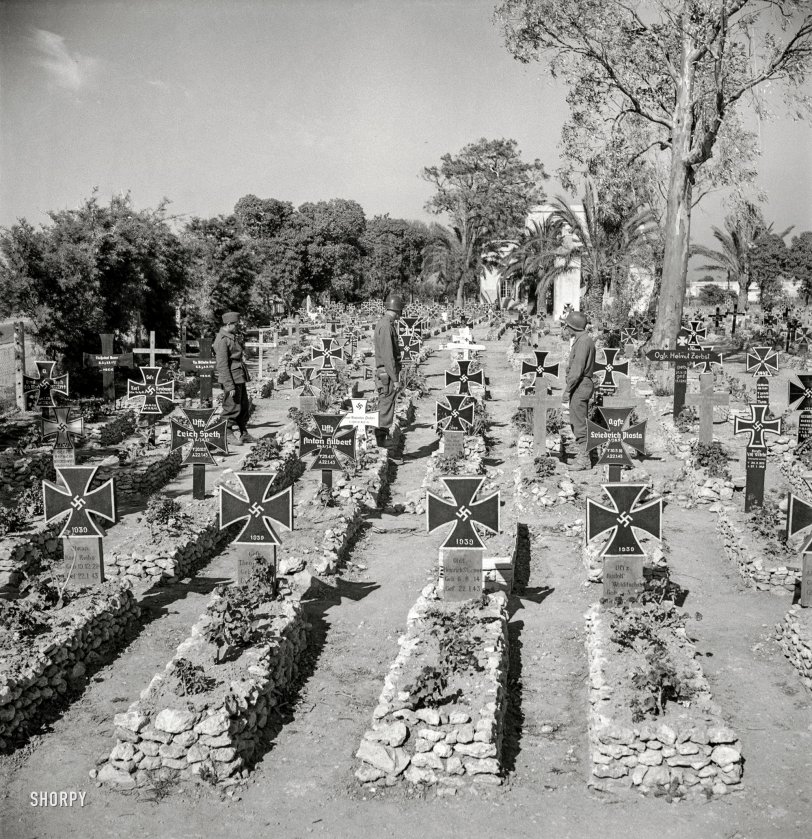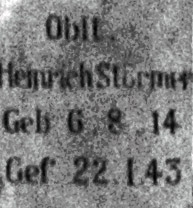


Framed or unframed, desk size to sofa size, printed by us in Arizona and Alabama since 2007. Explore now.
Shorpy is funded by you. Patreon contributors get an ad-free experience.
Learn more.

- Freeze Frame
- Texas Flyer wanted
- Just a Year Too Soon
- WWII -- Replacing men with women at the railroad crossing.
- Yes, Icing
- You kids drive me nuts!
- NOT An Easy Job
- I wonder
- Just add window boxes
- Icing Platform?
- Indiana Harbor Belt abides
- Freezing haze
- Corrections (for those who care)
- C&NW at Nelson
- Fallen Flags
- A dangerous job made worse
- Water Stop
- Passenger trains have right of way over freights?
- Coal
- Never ceases to amaze me.
- Still chuggin' (in model form)
- Great shot
- Westerly Breeze
- For the men, a trapeze
- Tickled
- Sense of loneliness ...
- 2 cents
- Charm City
- What an Outrage
- Brighton Park
Print Emporium
Springtime for Hitler: 1943

June 1943. Tunisia. "A German military cemetery on the outskirts of Tunis." Photo by Marjory Collins for the Office of War Information. View full size.
Troy's family ties
Troy, I don't know how to send you an email so I would like to offer you some help to gather some more informations about your geat uncles, especially your great uncle Karl.
I need his Christian name, his surname and his exact date of birth to probably give you some more informations. In the recent past there were several operations of the Kriegsgräberfürsorge/German War Graves Commission and same organisations of other European countries to unite spreaded graves of dead soldiers and other people who had died by war impact in Europe.
Moved
Originally, the dead of the German armed forces were interred in six provisional farmyards in Wetts, Bizerta , La Mornaghia, El M'Dou, Mateur and Sfax .
After a treaty agreement with Tunisia in 1966, they abandoned these existing graveyards and moved the dead from there (and from dispersed field graves) to the German Soldiers' Cemetery at Bordj Cedria.
I'm guessing that the dates at the bottom of the crosses are the soldiers' enlistment dates.
[The bottom is the death date. (Geb = Geboren; Gef = Gefallen. - Dave]

War Is Hell
My father was a tank commander in Tunisia with the First Armored Division during late 1942 and early 1943. The dates on these graves appear to be from around that time period.
Family ties
Four of my great uncles fought on the German side, one is buried outside of Düsseldorf, having been killed in the invasion of Belgium. Another is buried somewhere in what is now Belarus, trying to hold back the Soviet army. The other two are buried outside of their home town of Dresden, also trying to hold back the Soviet army.
My grandparents left Germany after the War, emigrating to the United States in 1947. They still could never find the grave of Uncle Karl, but always three times a year went to Nordfriedhof Dresden and Golzheimer Friedhof cemeteries to lay flowers.
I cannot help but wonder now if these graves were desecrated because of the 1939 iron cross headstones, or if the graves were destroyed after the war.
























On Shorpy:
Today’s Top 5